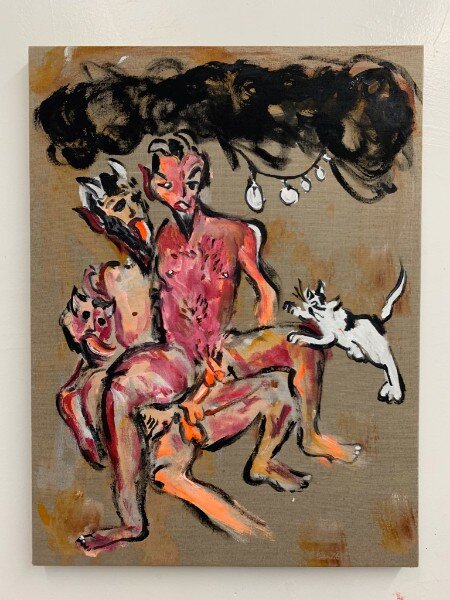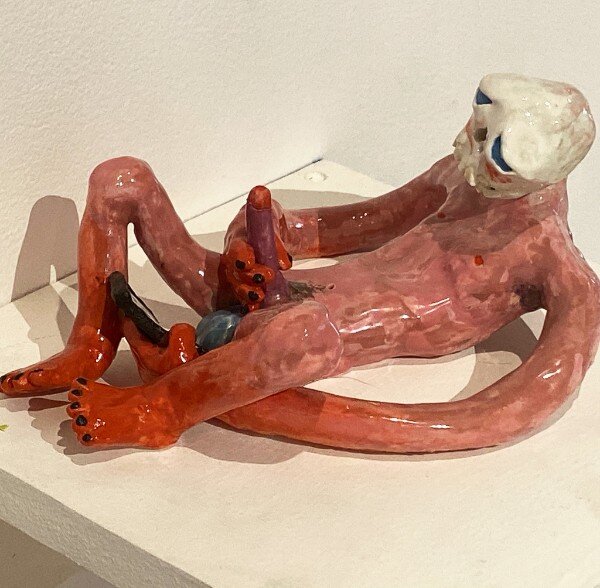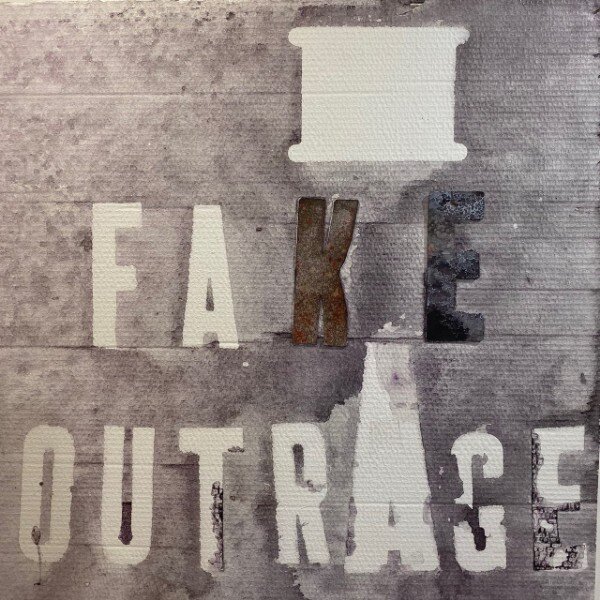INSTAGRAMMED AND CANCELLED
Essay by Bill Arning
I have a backyard with a pool. That is possible in my life because I left NYC in 2000. Now three months into quarantine I am very happy for that choice. I fill my bird feeder in the morning, visit artists studios around the world via FaceTime, FaceBook Messenger and What’s App and I write essays that perhaps art-curious readers might have more time to read during lockdown.
I was born and raised in New York City, the city that has been the center of the art world for the last eleven decades. The possibility that downtown Manhattan might lose its preeminence as the trading/exhibition center still seems impossible but since Paris lost its primacy over a century ago we know it’s inevitable that this center too shall pass.
Whether that means a new art capitol or a reimagined period without clear centers is unknown. Such systemic epochal shifts causally follow technological advances. And how forces beyond art, aesthetics, and philosophy will negatively impact much needed improvements and how our collective best intentions wave little to do with how this happens.
We might heartily believe a decentralized art world Would make for better arts production, more grounded and involved artists, being based in locations that feed their creative agency best. New possibilities for makers produced by technology advances will only take hold if artists are convinced that using them will make for better art making lives.
Even as Brooklyn took on a greater prominence as an art manufacture location its stature was always in relation to its easy proximity to the location of the prime art trading locus that Manhattan continues to be. In 2000 I moved to Cambridge MA and in 2009 to Houston TX.
While I have lovingly explored other art scenes throughout my career - both domestically and internationally—I had never before been so deeply involved with artists for whom living in New York was not the goal. I always assumed everyone given a choice would pick the hustle of trying to “make it in NYC”. And learning other life choices were possible shattered my sense of New Yorker exceptionalism.
Still Boston artists were very aware of the proximity to New York and its gallery possibilities and most stayed for the life style choice of Boston-area steady teaching jobs. Any younger artist with ambition was monthly on the bizarrely cheap “Chinatown bus” that drove from Boston to New York’s Chinatown at breakneck speed. Older artists joined me in the Amtrak “quiet car” more expensive but a blissful four hours of quality reading time with Long Island sound views. There was a community that noticed when artists ambitions started failing them and they chose quiet time weekends at home over connecting with New York, the first sign that the studio would soon be abandoned and teaching would become their ONLY creative outlet.
“Life style” was not the reason as Boston is nearly as expensive as New York and few had the huge studios and low cost of living that I soon learned made the rest of America appear on the mental horizon as possible future location locations. Artists, who had suffered the indignities of two money jobs and three roommates to get to NYC for their careers and to spend their youthful energy at noise concerts, sex parties and dance performances were suddenly “city shopping.”
City Shopping was endemic as artists near my age were watching their studio rents triple in a few years and realized that even if they sold everything they made they would still be losing money and be supporting their studio practice with graphic design or erotic massage. My studio conversations started with, “could I be based in Detroit? Or I heard San Antonio is cool, and that was always predicated on the ease of being in touch via the Internet.
I have a long history curatorially working with artists whose work is queer, political and highly sexually charged. AIDS defined my generation and making work that did not shrink form the joys of sex was politically required. Those types of artists exist everywhere and I immediately connected with that community in my new home of Houston, Texas.
The museum world exists in the perpetual cognitive dissonance of being “edgy” on command and within very proscribed limits – a contraction I had fully internalized as necessary. Having to build a room to keep sensitive viewers from seeing Marilyn Minter’s porn paintings seemed allowable. Attending a three-hour all-staff meeting debating whether an MPA photograph that included a painted female nipple needed to be hidden from donors seemed merely a funny soul-killing part of the game.
My first commercial foray under my own business name of Bill Arning Exhibitions was a huge sex, drugs and death shindig called No Trigger Warnings, at Houston’s storied Flatland Gallery. Fans of my curatorial practice all walked in and noted this was the type of show I clearly wanted the museum to do, but couldn’t.
I embraced my dinosaur status as a 59-year-old gay man who still believed the path to mental liberation was through desire and fueled by normal libidinal impulses. I knew that young people who should be celebrating their sexuality were instead self-policing for fear that their lusts would reveal them to be less “woke” than their friends. They would rather “cancel” a culture heroes life work than admit that the business of being a sexual human is messy and prone to multiple interpretations. This generational shift appears universal with only a few dissenting opinions representing more ribald future utopias.
No Trigger Warnings was intended as a statement against self –policing of all sorts. I was perpetually angry for my friends who teach would tell me about the climate of fear and censorship coming from supposed progressive thinkers. Mark Flood made a work for the show that was hung right as you entered that merely said in white on silver letters Fake Outrage.
Flood is the most famous artist who chose to remain in Houston after achieving fame along with Dario Robleto, Joseph Havel and Trenton Doyle Hancock. Texas is very self-conscious of its status as nearer a country than a state. There are multiple books on Texas art history that one must read to work in art here. My career today is involved in sowing Texas artists wherever I can and getting them attention outside the state and the country,.
(Artworks from No Trigger Warnings at Flatland Gallery, October 2019 by Scooter LaForge, Colin Radcliffe and Mark Flood)
In all the city-shopping my friends are doing I always suggest that Houston and San Antonio are increasingly marvelous places to be based. Large inexpensive studios and a supportive collector base are two factors well worth considering in deciding where to be. Good food makes up for the lack of walkable neighborhoods. Such a relocation requires that one remains a worldly Texas artist and most rise the social media challenge that being in the southern middle of a vast country entails. Yet that is easier for an abstract painter specifically because of online censorship.
My audience is increasingly global and now that I am selling art too my collectors are everywhere and I knew the odds of selling anything to art collectors in Houston was remote, and in fact only one piece stayed local. I was mainly sending PDFs of all the work to folks I knew would be interested but I relied on Instagram and my dealer Instagram account to attract people new to me, but here was the rub. Most of the work could at least potentially get me kicked off my social media.
I anticipated it would be the sexual content that would send me to Instagram and FaceBook prison. I had a massive painting by Scooter LaForge featuring a scintillating auto-fellatio scene, and Erik Hanson Bluto three way orgies, but no, social media allowed those.
It was a beautiful, tragic, and poignant work by Steve Locke, a tapestry which showed a photo of the artist as a seven year old child repeated twice, once with the phrase God Is Love and the second with the words “you Little Faggot” the piece summarily showed how his family of origin sent him strongly mixed messages as to his value in God’s universe and his family.
As part of the show I had evening events, Film Screenings, performances, dance, circus acts and stand up comedy, Comedy came first with a marvelous night organized by Bob Morrissey a writer, visual artist and stand up comic who curates a regular night in Houston called Gay Shame Parade- "Stand Up from Gays, Probable Gays, & People We Wish Were Gay." Keisha Hunt a tiny black lesbian who is funny and dirty enough to make me blush was the headliner. But the natural place to have the performers perform was in front of the Locke piece and that was where the trouble started.
I am GOOD at my social media. I was curator at MIT List Center when FaceBook was invented ten blocks away and I was in a number of MIT arts discussions about how to use these new platforms to get MIT students to make art a part of their lives.
I know the bulk of the people that intended to attend would be within a five-minute drive and if I posted images in real time they could still make it to see the final comedians. I posted a great photo of Morrissey hand raised like a preacher with God and Faggot bookending his head. I was immediately warned that “Hate speech was not allowed on Instagram
Any human seeing the artwork would realize the Faggot was being used politically and not against queer folks but knowing ones powerlessness with Instagram I immediately cropped the photo until Morrissey was just seen looking like a Southern preacher preaching with “God Is Love” as the caption. The comic is rigorously opposed to all forms of organized religion and immediately responded to the Instagram image that “God Is Love” was NOT his message. By the time Keisha Hunt was on stage telling jokes about her vagina I was positioned so Faggot would be nowhere to be seen in any image online.
The rest of the night I posted images without the offending Faggot and barely thought about the implications of my acceptance of heinous censorship. I am of course in a weird bind here. As a big proud Faggot I don’t mind being called Faggot and usually respond with a polite thank you for the recognition. I have a hard time being angered when I get a “cocksucker” hurled at me cause I am proud of that talent as well. But I don’t want my more fragile queer friends feeling at risk when those words circle around them. My desire to explain how Locke was using Faggot was easy in person but in social media world not so much.
LEFT: Comedian and visual Artist Bob Morrisey hosting Gay Shame Parade as part of No Trigger Warning RIGHT: Monologist and HIV anti-stigma activist performs at Flatland Gallery
The closing event was a reading by New Orleans artist Skylar Fein entitled an evening of diabolical Faggotry and the FaceBook event prompted a few raised eyebrows and stern emails but it was not taken down.
I wanted to complain about what I thought was a shocking event of censorship but it Turns out my community of creative people in Texas had so long been dependent on Instagram to get into dialog with the global art world that my shocked anger at having to crop Faggot out, misrepresent both the art worked and the performances was normalized.
Still I am constantly shocked by what causes the Instagram algorithm to bite. I saw a show presented by New Discretions in New York of Tom Bianchi wall constructions which I Instagrammed and was taken down just for a single offending muscular and sexy male butt. I merely regrammed a marvelous Nathan Ritterpusch painting that he posted without incident and I was not only censored but FaceBook banned me from posting new content for 48 hours.
I took a young artist from Houston on a New York gallery tour and he surprised the dealers who came out to greet me with knowing all of their rosters. He was all of 20 and lived with his DJ dad in the Houston Heights and rarely got to visit NYC. When I asked how he knew these artists he said he spent all day every day on gallery Instagram pages. I was impressed by his youthful passions so I am clearly a fan of what these platforms make possible.
I dream of another better platform free of censorship, so artists from outside the centers will no longer need to incompletely represent their work to reach a larger world.




